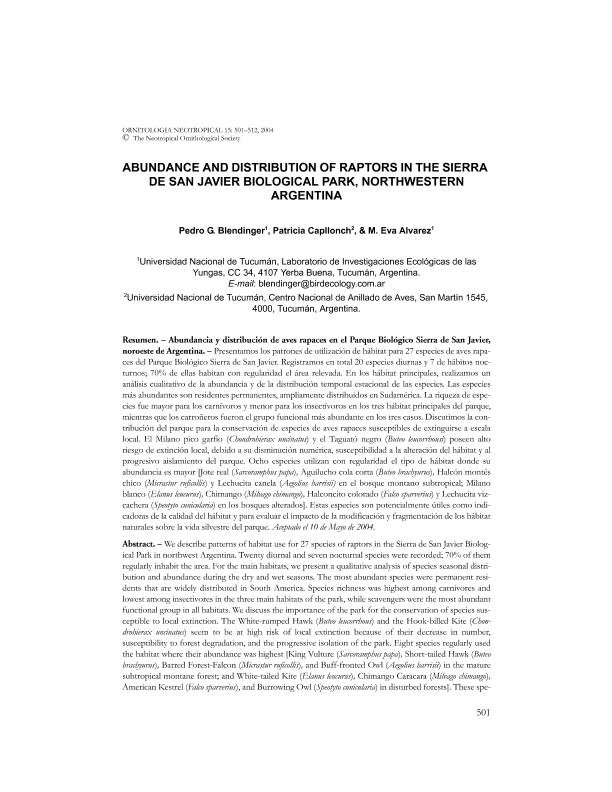Mostrar el registro sencillo del ítem
dc.contributor.author
Blendinger, Pedro Gerardo

dc.contributor.author
Capllonch, Patricia

dc.contributor.author
Alvarez, María Eva
dc.date.available
2020-04-01T13:43:22Z
dc.date.issued
2004-12
dc.identifier.citation
Blendinger, Pedro Gerardo; Capllonch, Patricia; Alvarez, María Eva; Abundance and habitat distribution of raptors in the sierra de San Javier biological park, northwestern Argentina; Neotropical Ornithological Society; Ornitología Neotropical; 15; 4; 12-2004; 501-512
dc.identifier.issn
1075-4377
dc.identifier.uri
http://hdl.handle.net/11336/101451
dc.description.abstract
Abundancia y distribución de aves rapaces en el Parque Biológico Sierra de San Javier, noroeste de Argentina. – Presentamos los patrones de utilización de hábitat para 27 especies de aves rapaces del Parque Biológico Sierra de San Javier. Registramos en total 20 especies diurnas y 7 de hábitos nocturnos; 70% de ellas habitan con regularidad el área relevada. En los hábitat principales, realizamos un análisis cualitativo de la abundancia y de la distribución temporal estacional de las especies. Las especies más abundantes son residentes permanentes, ampliamente distribuidos en Sudamérica. La riqueza de especies fue mayor para los carnívoros y menor para los insectívoros en los tres hábitat principales del parque, mientras que los carroñeros fueron el grupo funcional más abundante en los tres casos. Discutimos la contribución del parque para la conservación de especies de aves rapaces susceptibles de extinguirse a escala local. El Milano pico garfio (Chondrohierax uncinatus) y el Taguató negro (Buteo leucorrhousi) poseen alto riesgo de extinción local, debido a su disminución numérica, susceptibilidad a la alteración del hábitat y alprogresivo aislamiento del parque. Ocho especies utilizan con regularidad el tipo de hábitat donde su abundancia es mayor [Jote real (Sarcoramphus papa), Aguilucho cola corta (Buteo brachyurus), Halcón montéschico (Micrastur ruficollis) y Lechucita canela (Aegolius harrisii) en el bosque montano subtropical; Milano blanco (Elanus leucurus), Chimango (Milvago chimango), Halconcito colorado (Falco sparverius) y Lechucita vizcachera (Speotyto cunicularia) en los bosques alterados]. Estas especies son potencialmente útiles como indicadoras de la calidad del hábitat y para evaluar el impacto de la modificación y fragmentación de los hábitat naturales sobre la vida silvestre del parque. Aceptado el 10 de Mayo de 2004.Abstract. – We describe patterns of habitat use for 27 species of raptors in the Sierra de San Javier Biological Park in northwest Argentina. Twenty diurnal and seven nocturnal species were recorded; 70% of them regularly inhabit the area. For the main habitats, we present a qualitative analysis of species seasonal distribution and abundance during the dry and wet seasons. The most abundant species were permanent residents that are widely distributed in South America. Species richness was highest among carnivores and lowest among insectivores in the three main habitats of the park, while scavengers were the most abundant functional group in all habitats. We discuss the importance of the park for the conservation of species susceptibleto local extinction. The White-rumped Hawk (Buteo leucorrhous) and the Hook-billed Kite (Chondrohieraxuncinatus) seem to be at high risk of local extinction because of their decrease in number,susceptibility to forest degradation, and the progressive isolation of the park. Eight species regularly used the habitat where their abundance was highest [King Vulture (Sarcoramphus papa), Short-tailed Hawk (Buteo brachyurus), Barred Forest-Falcon (Micrastur ruficollis), and Buff-fronted Owl (Aegolius harrisii) in the mature subtropical montane forest; and White-tailed Kite (Elanus leucurus), Chimango Caracara (Milvago chimango), American Kestrel (Falco sparverius), and Burrowing Owl (Speotyto cunicularia) in disturbed forests]. These species are potentially useful as indicators of habitat quality and in assessing the impact of habitat fragmentation and modification on the park’s wildlife.Key words: Argentina, conservation, ecological indicator, raptor, subtropical montane forest, Tucumán.
dc.description.abstract
We describe patterns of habitat use for 27 species of raptors in the Sierra de San Javier Biological Park in northwest Argentina. Twenty diurnal and seven nocturnal species were recorded; 70% of them regularly inhabit the area. For the main habitats, we present a qualitative analysis of species seasonal distribution and abundance during the dry and wet seasons. The most abundant species were permanent resi- dents that are widely distributed in South America. Species richness was highest among carnivores and lowest among insectivores in the three main habitats of the park, while scavengers were the most abundant functional group in all habitats. We discuss the importance of the park for the conservation of species susceptible to local extinction. The White-rumped Hawk (Buteo leucorrhous) and the Hook-billed Kite (Chon- drohierax uncinatus) seem to be at high risk of local extinction because of their decrease in number, susceptibility to forest degradation, and the progressive isolation of the park. Eight species regularly used the habitat where their abundance was highest [King Vulture (Sarcoramphus papa), Short-tailed Hawk (Buteo brachyurus), Barred Forest-Falcon (Micrastur ruficollis), and Buff-fronted Owl (Aegolius harrisii) in the mature subtropical montane forest; and White-tailed Kite (Elanus leucurus), Chimango Caracara (Milvago chimango), American Kestrel (Falco sparverius), and Burrowing Owl (Speotyto cunicularia) in disturbed forests]. These species are potentially useful as indicators of habitat quality and in assessing the impact of habitat fragmentation and modification on the park’s wildlife.
dc.format
application/pdf
dc.language.iso
eng
dc.publisher
Neotropical Ornithological Society

dc.rights
info:eu-repo/semantics/openAccess
dc.rights.uri
https://creativecommons.org/licenses/by-nc-sa/2.5/ar/
dc.subject
Argentina
dc.subject
conservation
dc.subject
ecological indicator
dc.subject
raptor
dc.subject
subtropical montane forest
dc.subject
Tucumán
dc.subject.classification
Ecología

dc.subject.classification
Ciencias Biológicas

dc.subject.classification
CIENCIAS NATURALES Y EXACTAS

dc.title
Abundance and habitat distribution of raptors in the sierra de San Javier biological park, northwestern Argentina
dc.title
Abundancia y distribución de aves rapaces en el parque biológico sierra de San Javier, noroeste de Argentina
dc.type
info:eu-repo/semantics/article
dc.type
info:ar-repo/semantics/artículo
dc.type
info:eu-repo/semantics/publishedVersion
dc.date.updated
2020-03-30T14:35:07Z
dc.journal.volume
15
dc.journal.number
4
dc.journal.pagination
501-512
dc.journal.pais
Canadá

dc.journal.ciudad
Ontario
dc.description.fil
Fil: Blendinger, Pedro Gerardo. Consejo Nacional de Investigaciones Científicas y Técnicas. Centro Científico Tecnológico Conicet - Tucumán; Argentina. Universidad Nacional de Tucumán. Facultad de Ciencias Naturales e Instituto Miguel Lillo. Laboratorio de Investigaciones Ecológicas de las Yungas; Argentina
dc.description.fil
Fil: Capllonch, Patricia. Universidad Nacional de Tucumán; Argentina
dc.description.fil
Fil: Alvarez, María Eva. Universidad Nacional de Tucumán. Facultad de Ciencias Naturales e Instituto Miguel Lillo. Laboratorio de Investigaciones Ecológicas de las Yungas; Argentina
dc.journal.title
Ornitología Neotropical

dc.relation.alternativeid
info:eu-repo/semantics/altIdentifier/url/https://sora.unm.edu/sites/default/files/journals/on/v015n04/p0501-p0512.pdf
Archivos asociados
